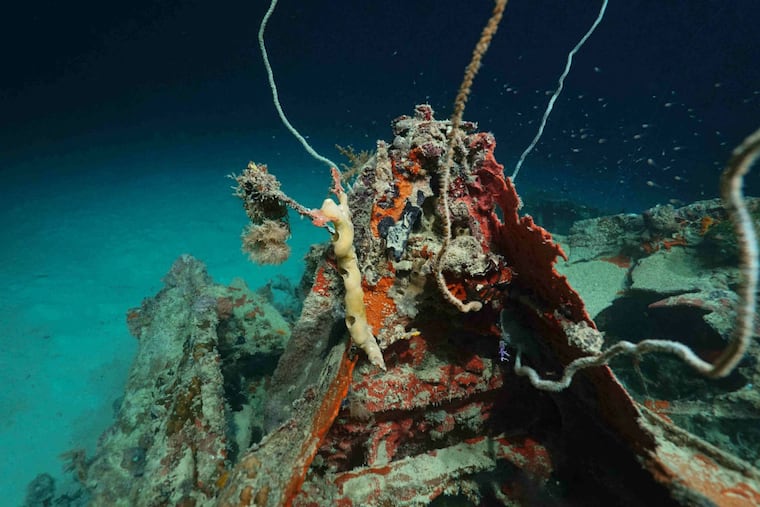Missing WWII airplane found by underwater robot
The twisted heap of metal had been lost underwater since July 1944, a casualty of fierce combat over the Pacific island of Palau.

The twisted heap of metal had been lost underwater since July 1944, a casualty of fierce combat over the Pacific island of Palau.
Lost, but not forgotten. This week, a research team that includes University of Delaware scientists announced it had found the TBM-1C Avenger with the help of sonar-equipped underwater robots.
The downed plane was scarcely recognizable as an aircraft, overgrown with coral and algae and mangled by the force of its landing.
The research group, called Project Recover, identified the wreck as an Avenger largely by its distinctive gun turret, said Mark Moline, director of Delaware's School of Marine Science and Policy.
"When it's coming in at 400 knots, it doesn't look much like a plane anymore," he said.
The find marks the fifth time that the group has found a World War II plane since 2012, when Delaware joined the effort along with the Scripps Institution of Oceanography at the University of California, San Diego.
The two schools teamed with the BentProp Project, a nonprofit group of historians that had been looking for wartime crash sites since 1993. The three entities established the Project Recover partnership at first with funds from the Office of Naval Research, and later from Texas businessman and philanthropist Dan Friedkin.
Moline returned to Delaware on Wednesday after a 26-hour journey with colleagues Megan Cimino and Hunter Brown.
The trio had to change planes in Guam, Hawaii, and finally Denver before arriving at Philadelphia International Airport.
Cimino, who earned her Ph.D. in oceanography this spring, said the discoveries made for a solemn experience.
"You go from excitement, because you've spent so much time looking for these sites," Cimino said. "And then it can also be pretty emotional when you realize what's underneath, and you're thinking about what happened."
The group does not divulge whether the wrecks contain the remains of American servicemen. Information on the sites is turned over to the Pentagon's Defense POW/MIA Accounting Agency, which is tasked with recovery and repatriation efforts, including contacting surviving relatives.
Cimino said the work prompted her to ask her family for more details about her late grandfather, a Navy diver who saw action in Normandy.
Brown, an ocean engineer at Delaware, said he was reminded of his great-uncle, a Marine who fought in Iwo Jima and Okinawa.
Project Recover members say dozens of sites remain to be found in the Pacific, hidden underwater or in dense mangrove forests.
The underwater robots the team uses are torpedo-shaped devices, programmed to travel back and forth slowly as they scan the seafloor below.
Based on historical accounts, the team suspected that the Avenger lay somewhere in a harbor measuring more than three square miles, but had few specifics.
"Over the past three years, we've been slowly knocking off sections of the entire harbor area," Moline said.
The type of scanning used, called side-scan sonar, revealed many possible targets, but only a few turn out to be planes, he said. The team studies the images to determine which are worthy of follow-up with diving equipment.
The Avenger lay in waters about 85 feet deep, said Eric Terrill, a Scripps oceanographer who dived down to take photographs. Protruding from the top of the wreck was the back of the pilot's seat, tinged with a reddish substance that is probably a type of algae, he said.
Delaware's Moline maintains a busy schedule of oceanographic research, but the quest for wartime aircraft is now a fixed part of his schedule.
The team is headed to England this summer in search of another.
215-854-2430 @TomAvril1